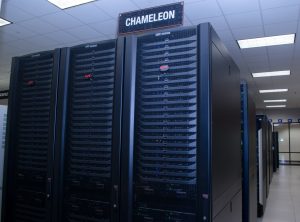Cloud computing lies behind many of today’s most popular technologies, from streaming video and music to email and chat services to storing and sharing family photos. Since 2015, the Chameleon testbed has helped researchers push the potential of cloud computing even further, finding novel scientific applications and improving security and privacy.
 A new grant from the National Science Foundation will extend Chameleon’s mission for another three years, allowing the project led by University of Chicago with partners at the Texas Advanced Computing Center (TACC), Renaissance Computing Institute (RENCI), and Northwestern University to enter its next phase of cloud computing innovation. Upgrades to hardware and services as well as new features will help scientists rigorously test new cloud computing platforms and networking protocols.
A new grant from the National Science Foundation will extend Chameleon’s mission for another three years, allowing the project led by University of Chicago with partners at the Texas Advanced Computing Center (TACC), Renaissance Computing Institute (RENCI), and Northwestern University to enter its next phase of cloud computing innovation. Upgrades to hardware and services as well as new features will help scientists rigorously test new cloud computing platforms and networking protocols.
The $10 million renewal was officially announced at the inaugural Chameleon User Meeting, held Sept. 13-14 at Argonne National Laboratory.
“In phase one we built a testbed, but in phase two we’re going to transform this testbed into a scientific instrument,” said Kate Keahey, Argonne computer scientist, Computation Institute fellow, and Chameleon project principal investigator (PI). “We’re going to extend the capabilities that allow users to keep a record of their experiments in Chameleon and provide new services that allow them to build more repeatable experiments.”
Phase two funding also will include new hardware, including additional racks at UChicago and TACC, and infusion of highly-contested resources, such as GPUs and Corsa network switches. The new Corsa switches enable experimentation with software-defined networking (SDN) within a Chameleon site as well as extending individual SDN experiments across the wide-area to include resources from either Chameleon site or even from other compatible testbeds, such as the NSF’s Global Environments for Network Innovations (GENI) and ExoGENI, a nationwide GENI testbed effort led by RENCI.
RENCI will receive about $800,000 that will develop the software that will allow researchers to take full advantage of the Corsa switches. The goal, said RENCI’s Paul Ruth, is to provide researchers with virtual network switches that they can configure at line rate as SDN-enabled OpenFlow virtual switches.
“Our work will make it possible to hand over the configuration of network switches to the researcher, and because they are virtual switches, they won’t affect network traffic or other experiments,” said Ruth, a senior distributed systems researcher at RENCI and the lead RENCI PI on the project. “This capability is not available to most researchers at this time. It could be a significant resource to scientists interested in SDN research.”
The RENCI team will also work to give Chameleon researchers access to the distributed networked infrastructure-as-a-service called ExoGENI, which connects resources at 19 sites in the U.S., Canada, Europe and Australia.
The phase two work will build upon the project’s original philosophies of flexibility and transparency, which provided users with a large-scale, ~600-node cloud infrastructure with bare metal reconfiguration privileges. This unique level of access allows researchers to go beyond limited development on existing commercial or scientific clouds, offering a customizable platform to create and test entirely new cloud computing architectures.
In its first phase, this powerful resource supported advanced work in computer science areas such as cybersecurity, OS design and power management. With Chameleon, scientists could realistically simulate cyberattacks upon cloud computing systems to improve their defenses, train students to search high-resolution telescope images for undiscovered exoplanets, and develop machine learning algorithms that automatically determine the most energy-efficient task assignment schemes for large data centers.
On the software side, the Chameleon team will package CHI (CHameleon Infrastructure), the software operating Chameleon, based primarily on the open-source OpenStack project to which the University of Chicago team made substantial contributions. Packaging the Chameleon operational model will allow others to create their own experimental clouds easily.
“Whether somebody wants to provide a Chameleon resource or create their own experimental testbed, CHI will make it very easy for them” Keahey said. “It is based on a widely used open source system that is increasingly popular in scientific data centers and thus easy to adopt. Ultimately, we would like to make testbeds for Computer Science research cost-effective to operate”.
The project will also look to expand their community through outreach events, including workshops, online tutorials, and September’s user meeting. In addition to training scientists in the use of Chameleon and gathering feedback for future improvements, these events will also be an opportunity for defining the future of cloud computing science, Keahey said.
“We would like to go beyond simply providing resources, and give the community the opportunity to focus on experimental methodology in computer science: how to improve it, how to control it, and how to make experimental computer science less about logistics and more about the science.”


